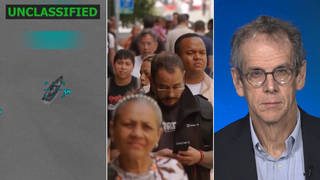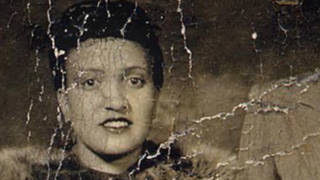
Topics
Denver-based journalist Eileen Welsome reveals how as a reporter for the tiny Albuquerque Tribune (circulation 35,000) she uncovered one of the country’s great Cold War secrets: the U.S. government had knowingly exposed thousands of human Guinea pigs with radiation poisoning including 18 Americans who had plutonium injected directly into their bloodstream. [includes rush transcript]
In a Massachusetts school, seventy-three disabled children were spoon-fed oatmeal laced with radioactive isotopes.
In an upstate New York hospital, an eighteen-year-old woman believing she was being treated for a pituitary disorder, was injected with plutonium.
At a Tennessee clinic, 829 pregnant women were served “vitamin cocktails” containing radioactive iron, as part of their regular treatment.
No these are not acts of terrorism by common criminals.
These are just some of the secret human radiation experiments that the U.S. government conducted on unsuspecting Americans for decades as part of its atom bomb program.
In a gruesome plot that spanned 30 years, doctors and scientists working with the US atomic weapons program, exposed thousands of unwilling and unknowing Americans to radiation poisoning to study its effects.
For years, the experiments by the U.S. government and the identities of their human guinea pigs were covered up.
Then after a six-year investigation, investigative reporter Eileen Welsome uncovered the names of 18 people who were injected with plutonium in the 1940s without their knowledge by federal government scientists. In 1993, she published her finding in The Albuquerque Tribune and later received the Pulitzer Prize for her work.
Another six years later, Welsome published “The Plutonium Files: America’s Secret Medical Experiments in the Cold War.” The book gives a detailed account of the unspeakable scientific trials conducted by the U.S. government that reduced thousands of American men, women, and even children to nameless specimens.
- Eileen Welsome, Pulitzer prize-winning reporter and author of “The Plutonium Files: America’s Secret Medical Experiments in the Cold War.”
Transcript
AMY GOODMAN: After a six-year investigation, reporter Eileen Welsome uncovered the identities of eighteen people injected with plutonium in the 1940’s without their knowledge by federal government scientists. Eileen Welsome published her findings in a series in the “Albuquerque Tribune” and received the Pulitzer Prize for her work. It took another six years for her to complete her book called “The Plutonium Files, America’s Secret Medical Experiments in the Cold War.” She joins us now in Boulder, Colorado. Eileen Welsome, thanks for joining us.
EILEEN WELSOME: Happy to be here. Thank you for having me.
AMY GOODMAN: Over the years we have spoken with you, but now that we’re on this tour and you live in Denver, this is a rare opportunity to sit down and go through this story. First, how did you even get a clue that this was going on?
EILEEN WELSOME: Amy, it started, as you mentioned earlier, I was a reporter at the “Albuquerque Tribune” and I was doing some research on an air force base there, and they were doing some cleanup work. I noticed that in the document there were several radioactive animal dumps on this air force base. So I was curious about what kind of animals were in the dump and why were they radioactive? So I went over to the air force base, Kirkland Air Force Base, to what was then called the Air Force Special Weapons Laboratory. And they got out a big stack of these dusty reports for me to read on these animal studies. And so as I was thumbing through these reports, and it was horrible because they were incubating beagles and watching them develop cancers and how long they lived and charting the radiation sickness. But as a reporter, there wasn’t a story there for me. These were old experiments and as gruesome as they were, it wasn’t something that a daily newspaper would be interested in. So it was about 5:00 on Friday, I was eager to go home, but I felt like I had gone to this trouble to get these documents and I had to make my time look good. So I kept flipping through the reports. And my eye fell on a footnote and the footnote mentioned something about 18 humans who had been injected with plutonium. So I kind of reared back in my seat. I was just shocked. Shocked to think that our government had injected 18 people with plutonium. So I jotted down what I could from the citation and the next day, which was a Saturday, I went to the university library there and started hunting up reports about these scientists. So that was the beginning of it and the reason I looked at the footnote, I need to say this, is I had done a lot of financial reporting prior to that time and I know that whenever a company wants to put in the bad news, it’s always in a footnote. So that taught me to look at footnotes.
AMY GOODMAN: And so how did you begin to unravel this story?
EILEEN WELSOME: Well, here was my problem: I learned there were some scientific reports in the literature, so I got those reports. I started to cull everything I could. And I learned that there were 18 people that had been injected with plutonium, but they were known by code numbers only. So the problem for me became how to find 18 Americans that had been injected with plutonium 30 or 40 years ago in a country of millions. So I thought that — I mean, it was an impossible task, and so I started very crudely. I put these 18 code numbers on yellow sheets of paper and then as I gathered documents, I would write down what I knew about each of these 18 people. So I eventually learned their ages, the date they were injected, what kind of disease they had, if there was an autopsy or a biopsy conducted, and when they died. And then it was just a matter of continuing to do that and pick up clues.
AMY GOODMAN: Tell us about one of the 18 people.
EILEEN WELSOME: Well, I had gone off on a journalism fellowship and I had been filing Freedom of Information Act requests with the federal government. So I had a tiny folder on this experiment and when I came back and looked — I pulled out my folder and I had fresh eyes. And I looked at this document again and these documents were redacted. In other words, the names of the patients were whited out and so were the names of the doctors. And my eye fell on this line, which said Doctor so and so contacted the physician of Cal-3 in Italy, Texas. And what leapt out at me were the words, Italy, Texas. By then, I knew a lot about Cal-3. I knew he was an African American man who would have been 80 years old, who would have been — who had his left leg amputated three days after he was injected with plutonium. So given those few clues and that this person might have lived in Italy, Texas, I was determined to go there and knock on every door until I found this man.
AMY GOODMAN: We’re talking to Pulitzer Prize winning reporter Eileen Welsome. So tell us about your discovery, how you made contact.
EILEEN WELSOME: So I got out a map. I looked up Italy, Texas. It was south of Dallas, about 60 miles. I called directory assistance, got the number of Italy’s City Hall, called them up, introduced myself, described the person I was looking for and they said, “You’re looking for Elmer Allen, but he died a year ago. Would you like his wife’s number?” So I said, “Of course.” And I wrote the number down and within minutes I was talking to Mrs. Allen.
AMY GOODMAN: And what did you say?
EILEEN WELSOME: I was very circumspect because I didn’t want to frighten her and I didn’t want to seem like a kook and I didn’t want to put words in her mouth. I wanted to know what she remembered. So I simply said, you know, I had some documents that suggested that her husband may have been involved in a government-funded study and I would like to talk with her about it. And she asked me to talk to her daughter, Elmerine Allen Whitfield. And I called her and she was very quiet on the phone. As I reeled out my story, she said, “Ok, you can come on.” And so I flew to Italy, Texas, and we sat down at her kitchen table and by the end of the interview, I knew and they knew that I had found the first of these 18 people.
AMY GOODMAN: Elmer’s story?
EILEEN WELSOME: Elmer’s story.
AMY GOODMAN: What was Elmer’s story, how did he end up in a hospital being injected with plutonium?
EILEEN WELSOME: Elmer was a railroad porter. He and his wife were living in the Bay Area in the mid 1940’s. They had left Texas and gone out there to start a better life. They had two young babies. Elmer fell from the train in Chicago and damaged his leg, and that sort of put him into the medical system. That was the beginning of his participation in this experiment. And his leg did not heal and he kept going back to the doctor. Somehow he found himself in this clinic at U.C. San Francisco University of California Hospital in San Francisco, and they selected him for this radiation experiment.
AMY GOODMAN: But he didn’t know that?
EILEEN WELSOME: Oh, no, no, he absolutely did not know. He was told that he had an osteosargenic sarcoma in his knee and they would have to amputate in order to save him. There’s some question about whether he did or didn’t have that cancer and I do not know the answer to that. But three days before they amputated that leg, they injected him in the calf, intramuscularly, with plutonium.
AMY GOODMAN: Didn’t they — he describe to his wife how they put a target on his leg and they injected it in that?
EILEEN WELSOME: They eventually, with the consent of Mrs. Allen, I was able to get Elmer’s medical records from U.C. San Francisco and in those medical records, the doctors talked about putting that target on his calf prior to the injection.
AMY GOODMAN: Now, he never knew he was a subject in a U.S. government experiment, but he suspected something, is that right?
EILEEN WELSOME: Yes. He told a good friend of his in Italy, Texas, that the doctors kept flying in and out of his room practicing to be doctors. And he told his friend, “They guinea-pigged me.”
AMY GOODMAN: We interviewed Elmerine Allen a number of times and she talked about how growing up her father would say that, and then when she left for college, he said, watch out, “Don’t let the U.S. government guinea-pig you.” And they always thought that Elmer had some kind of, well, Elmer was kind of quirky, and he had this delusion that the government experimented on him.
EILEEN WELSOME: The sad part about and the tragic part about Elmer’s story is that nobody believed him. He went to his doctor and told him, you know, “I think I’ve been injected with something.” His doctor diagnosed him as a paranoid schizophrenic at the same time that he was conversing with the atomic energy scientists in Argonne National Lab to provide them with tissue samples and —
AMY GOODMAN: Wait, wait, wait. His doctor said he was a paranoid schizophrenic at the same time his doctor was providing Elmer’s tissues to the government scientists doing the experiment?
EILEEN WELSOME: That’s correct. That’s what the medical records show. So, Elmer was not only used in 1947 when he was injected with this radioactive isotope, but he continued to be used as a guinea pig for the rest of his life.
AMY GOODMAN: Being sent for example to where, Rochester, New York?
EILEEN WELSOME: In the — the experiment had two parts. In the 1970’s, the — in the 1970’s, a second generation of atomic scientists rediscovered this experiment. So they wanted to dig up all the people who were dead, who had been injected with plutonium, and they also wanted to bring whoever survived them back into the lab for further studies. And Elmer was one of those people.
AMY GOODMAN: Under what pretext since he didn’t know, supposedly, that he was a U.S. government guinea pig?
EILEEN WELSOME: They told Elmer, and this is all documented in the medical records, that they knew he had a very serious cancer and they wanted to know where he had lived so long.
AMY GOODMAN: Eileen Welsome is our guest. Pulitzer Prize winning reporter, unearthed the names of 18 people injected with plutonium by the U.S. government. When we come back, we’re going to talk about who these scientists were. We’ll hear more of the stories. And then also the group studies, the studies of hundreds of people who were given — well, a couple dozen disabled children in Massachusetts fed radioactive isotopes in their oatmeal, hundreds of pregnant women, also, served so-called vitamin cocktails containing radioactive iron — how this all happened without anyone knowing about it until recently. Stay with us.
AMY GOODMAN: This is Democracy Now! I’m Amy Goodman. As we continue looking at “The Plutonium Files: America’s Secret Medical Experiments in the Cold War.” We’re broadcasting from Boulder, Colorado and our guest is Pulitzer Prize winning reporter Eileen Welsome now lives in Denver. The lessons — let the lessons of history remind us that the best safeguard for the future is an informed and active citizenry. Let’s continue on this journey of the people who were injected, and the people who injected them. This certainly sounds a little like the Tuskegee experiments, but tell us, who ran this program?
EILEEN WELSOME: The program sounded in the Manhattan Project, the project to build the atomic bomb in the early 1940’s. Side by side with the physicists worked a group of doctors who were interested in finding out how to protect their own workers in the Weapons Complex. And also trying to figure out what these new radio isotopes did in the human body. So basically, the beginning was the fathers of the bomb project, the medical doctors and scientists that were the tier below the Nobel Laureates, below the Oppenheimers and so on.
AMY GOODMAN: Did they know this was happening?
EILEEN WELSOME: Certainly the records indicate that Oppenheimer approved the injections of these patients with Plutonium, because Los Alamos was fighting a severe contamination problem and the scientists working in those laboratories were concerned about their own health.
AMY GOODMAN: Didn’t Oppenheimer come from Berkeley, and you had Elmer who was injected in California?
EILEEN WELSOME: That’s correct. There was a large component of the atomic bomb project in the Bay area.
AMY GOODMAN: Conducted where?
EILEEN WELSOME: At the University of California at Berkeley and also at the university of California San Francisco.
AMY GOODMAN: So we’re talking about a nexus of university, military, working together?
EILEEN WELSOME: That’s exactly right. During the Manhattan Project, it was a very strange hybrid animal where you had people that were in the military working for the military, and you had people that were getting paid by universities.
AMY GOODMAN: The robbing of graves?
EILEEN WELSOME: That occurred — well, I don’t know if I would quite put it so strongly as that, but they did exhume bodies.
AMY GOODMAN: With the family’s consent?
EILEEN WELSOME: They sought the consent of the families, but they did not tell the families the true purpose for the exhumations.
AMY GOODMAN: What did they tell them?
EILEEN WELSOME: That they had been given some radio isotope or some chemical and wanted to see what it had done in the bodies of their loved ones.
AMY GOODMAN: Well, that’s true, isn’t it?
EILEEN WELSOME: Yes, but they didn’t use the word Plutonium.
AMY GOODMAN: Can you name a scientist and can you tell us what the response has been?
EILEEN WELSOME: When I did my research, most of the scientists, with the exception of Himer Fridel, who was the assistant medical director of the Manhattan Project, were dead.
AMY GOODMAN: The Manhattan Project being —
EILEEN WELSOME: The atomic bomb program. But the scientist who had conducted the more recent studies defended them. That they were important to protecting the workers in the nuclear weapons complex or that they were harmless.
AMY GOODMAN: So let’s go through the experiments. The 18 people injected with Plutonium, none of them knew that that had happened to them. But moving on, in a Massachusetts school, 73 disabled children spoon fed oatmeal that had radio isotopes in them, radioactive isotopes. What happened?
EILEEN WELSOME: In that case, this was a nutrition study and they were given radioactive calcium and other radio isotopes.
AMY GOODMAN: Every morning?
EILEEN WELSOME: In their oatmeal, it was either mixed into the oatmeal or in the milk. And these boys did not know what was being given to them, nor did their parents. And in fact, they were told that this was really something nutritious and good for them. They were asked to give blood samples, urine samples, feces samples.
AMY GOODMAN: How long did this go on for?
EILEEN WELSOME: It went on for a number of years. And these boys grew into men and did not find out what had been done to them until the 1990’s.
AMY GOODMAN: Upstate New York hospital, 18-year-old girl thinks she’s being treated for a pituitary disorder and gets injected with Plutonium?
EILEEN WELSOME: This was a young woman who like Elmer Allen wound up in a hospital at the wrong place and was injected.
AMY GOODMAN: Tennessee clinic, 829 pregnant women served radioactive iron as part of their regular treatment. What did they think they were getting?
EILEEN WELSOME: This was a study done immediately after World War II and these young women came to the clinic thinking that they were getting vitamins to drink, that this would help their babies. And in fact, what was being studied was how fast the radio iodine crossed into the placenta.
AMY GOODMAN: Where was this?
EILEEN WELSOME: At Vanderbilt University in Nashville.
AMY GOODMAN: And what happened to these women?
EILEEN WELSOME: They had all kinds of ailments, skin diseases, cancer, blood disorders, some of their offspring, their children that they were carrying at the time of this experiment died of cancer. And very strange cancers at young ages.
AMY GOODMAN: Were there any whistle blowers among the doctors and nurses?
EILEEN WELSOME: There was none whatsoever. The doctors closed ranks and considered this worthwhile science, and something they were doing to protect the country.
AMY GOODMAN: What about patients brought into the basement of the hospital and experimented on in the middle of the night, where was this?
EILEEN WELSOME: This was an experiment that was done in Cincinnati, Ohio. It was another one of these hybrid experiments that was half medical, half military. And in many cases, that’s the problem with hybrid experiments. Often times, what’s medically good for the patient is not militarily the best experiment. So these studies were done with cancer patients. They were told it would help their cancer. What the doctors were looking at was trying to figure out in the event of an atomic bomb detonation, how long could soldiers fight?
AMY GOODMAN: We’re talking to Eileen Welsome. Her series came out in the Albuquerque Tribune and she turned it into a book, the Plutonium Files. Your expose came out under the Clinton years. President Clinton set up an advisory committee on human radiation experiments, which did its own digging into radiation programs. Remarkably enough, the report, the final report, came out on October 3, 1995, the same day as the verdict in the O.J. Simpson case. I don’t remember seeing the results being reported.
EILEEN WELSOME: It was really unfortunate, because everybody in the country was focused on O.J. Simpson and —
AMY GOODMAN: Or was it timed right? Because let’s remember every day people were waiting to the Simpson verdict, so it clearly was not beyond the government commission to understand the attention of the nation was focused elsewhere.
EILEEN WELSOME: I hadn’t thought about that, Amy. It’s simply a possibility.
AMY GOODMAN: So the results came out anyway?
EILEEN WELSOME: The results came out anyway, and nobody paid attention to it.
AMY GOODMAN: And what were the results?
EILEEN WELSOME: Basically, they confirmed that thousands and thousands of experiments had been done on U.S. Citizens. That the victims were the most vulnerable people in our society: the young, the disenfranchised, the poor, people of color, people who did not know enough to ask questions. In other words, the subjects were not doctor’s children or friends of their doctors; they were people who were vulnerable.
AMY GOODMAN: And how many places did this happen in the United States? The school in Massachusetts, the Cincinnati test, Elmer Allen was at the University of California Berkeley, how many sites were these government scientists working in?
EILEEN WELSOME: There were hundreds of sites. There were private hospitals, public hospitals, military installations, orphanages. About any place that doctor was working where they might be able to get a grant.
AMY GOODMAN: Prison?
EILEEN WELSOME: Yes, that was a really, really ugly experiment. A group of prisoners had their testicles eradiated.
AMY GOODMAN: Where?
EILEEN WELSOME: In Oregon mostly. And the purpose was for NASA. They were interested in knowing the effects of space radiation on astronauts.
AMY GOODMAN: And what happened to these prisoners?
EILEEN WELSOME: Many of them that I interviewed were still in prison. They had all kinds of medical problems and cancers and health issues.
AMY GOODMAN: Lawsuits?
EILEEN WELSOME: Many, many lawsuits filed. Some of the families were compensated. The Plutonium patients got an average per family of $400,000. I think that was the largest. And patients at other sites around the country got lesser amounts.
AMY GOODMAN: What about today? Do you think which have learned anything? And as people listen to this, I’m sure there are many who will start to wonder.
EILEEN WELSOME: I think that the way to safeguard yourself, you as a patient or your loved ones as patients, is by asking questions. And the other way to safeguard — the other way to prevent these things from happening again is to make sure that what we do is open an available to the public. Because openness is a disinfectant and it keeps these kinds of malignant, unethical experiments from happening.
AMY GOODMAN: Yet we have entered an age of perhaps greater secrecy than ever before.
EILEEN WELSOME: That’s correct. In fact, I realized as I was doing my book, my intuition told me this was a small window that was closing and I don’t think that today I could get some of the documents that I was able to get for this book.
AMY GOODMAN: Soldiers?
EILEEN WELSOME: Thousands of soldiers were used in bomb tests in Nevada.
AMY GOODMAN: How?
EILEEN WELSOME: Well, they were ordered into the blast area within minutes after a detonation. They flew in — Air Force pilots flew into radioactive clouds. They detonated atomic bombs in the Pacific. The soldiers and sailors were then ordered in to retrieve various instruments that were contaminated.
AMY GOODMAN: And then there were not the people who were personally fed the radio isotopes, the kids at the school or the women who were given these vitamin cocktails that were radioactive. But there was the disbursing of radio activity in the air over cities, at schools?
EILEEN WELSOME: That’s correct. One of the most famous is the Green Run at the Hanford Reservation.
AMY GOODMAN: In Washington state?
EILEEN WELSOME: In Washington State in which they released radio iodine and the prairie was very hot, but that was one of the controversial findings in this committee report. They did not say or recommend that the government be forbidden from doing this. They basically said you need to have a committee and at some point the documents should be made public. I thought that was one of the worst recommendations that they came out with.
AMY GOODMAN: I want to thank you very much for being with us. What was the biggest revelation for you in this research and looking at the Plutonium Files?
EILEEN WELSOME: The biggest revelation for me was to see how cruel and inhuman these very educated doctors were toward their patients.
AMY GOODMAN: And not telling them?
EILEEN WELSOME: And not telling them.
AMY GOODMAN: And the medical establishment today, is it backing them up?
EILEEN WELSOME: They were when I was doing my research on this book. They still defended these experiments as being important.
AMY GOODMAN: Well, Eileen Welsome, thank you for being with us. The book is called “The Plutonium Files: America’s Secret Medical Experiments in the Cold War.” Tomorrow on Democracy Now!, we’ll be joined by Joyce Mescus, the owner of The Tattered Cover, an independent bookstore in Denver who has been talked about by many booksellers as the one who took on the US Government when police came in to get records of someone who had bought a book in her store. She spent tens of thousands of dollars fighting this case. We’re going to talk about what this means this day and age. We’re also going to speak with a doctor who has treated soldiers coming back from Iraq.












Media Options